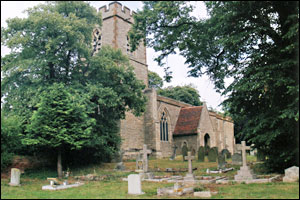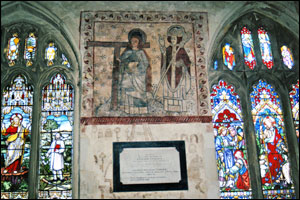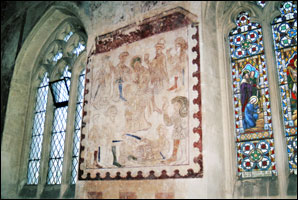![]()
The contents on this page remain on our website for informational purposes only.
Content on this page will not be reviewed or updated.
 |
|
 |
|
|
||||||||||||
|
Broughton: St. Lawrence Church, wall paintings.
|
||||||||||||
|
||||||||||||
|
At Broughton, consisting of a chancel, nave, south porch and embattled west tower, the church of St. Lawrence dates mainly from the late 13th and early 14th centuries, and from this period on the walls of the nave may be seen several magnificent ‘morality paintings.’ Having been covered over at an earlier date, they were discovered by the rector in 1849, and are amongst the finest to be seen in our region. As an age of general illiteracy, in medieval times the intent was to portray religious scenes to the congregation, and more especially the consequence of straying from the Biblical teachings. Thus it is no coincidence that on entering the church by the south door the first depiction to be seen - directly opposite, above the north doorway - is that of the Last Judgement. On the south wall is portrayed St. George on horseback, slaying the dragon, and also on the south wall are to be seen two figures, one of whom is holding a T shaped cross (known as the Tau Cross.) In fact this is held by St. Helena, the mother of the Emperor Constantine, who reputedly discovered the true cross. Beside her is probably St. Eloi, the patron saint of blacksmiths, since the tools of his trade are depicted below the painting. As for the north wall, here may be seen a ‘Pieta,’ ie. a representation of the mutilated body of Christ in his mother's arms. Apart from the paintings, also of note in the church are two ancient chained books, resting on shelves either side of the chancel arch, and one, by Bishop John Jewel, is an ’Apologie,’ or defence, of the Church of England. Regarding the nation’s religion, between 1549 and 1662 the English Acts of Uniformity were passed, but with this provoking reaction from the ‘Dissenters,’ - those not accepting the established church - the Bishop’s book, printed at Fleet Street, London, and dated 1567, is an early defence of the accepted practices of the Church at that time. In the then rector’s handwriting, on the opening pages of the other book is recorded that its purchase was made in 1632 for the church and parish, the volume being by Erasmus and entitled a ‘Paraphrase of the New Testament.’ Erasmus, who occupied the Lady Margaret chair of Divinity and the chair of Greek at Cambridge in the early 16th century, attempted to introduce a more rational Christian doctrine, and in fact his tutor was William Grocyn, who, as a past rector of Newton Longville, is commemorated in the village church by a brass on the north wall as the ‘First Teacher of Greek in the University of Oxford.’ In this day and age, the murals of Broughton church may be viewed on the appropriate web site, but for anyone wishing to see them as they were intended, please note that the key to the church door has to be inserted into the lock upside down!
|
||||||||||||
|
|
||||||||||||
|
|
||||||||||||




